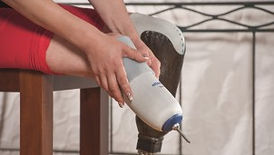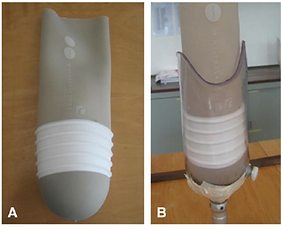Lower-Limb Amputee Rehabilitation
Transtibial suspension
An elastic sleeve is pulled over the prosthesis, in order to suspend the prosthesis to the individual’s leg through sheer force between the sleeve and skin above the prosthesis (Murphy, 2013; Spires, Kelly & Davis, 2013).
Fork strap and belt suspension
Sleeve suspension
Pin-lock Liner or Lanyard strap
Silicone suction liner
Seal-in liner
Utilises a belt around the individual’s waist, which runs along the anterior thigh and hooks onto a ‘Y” strap on the medial and lateral trim lines of the socket (Murphy, 2013; Spires, Kelly & Davis, 2013). Less commonly used today (Murphy, 2013).
A silicone liner is donned with a hypobaric sealing membrane (HSM) encircling the outside of the liner at the distal one third (Murphy, 2013; Spires, Kelly & Davis, 2013). A one-way expulsion valve is on the socket below the level of the HSM and is used to expel pocketed air to secure the suction from the membrane (Murphy, 2013; Spires, Kelly & Davis, 2013).
A liner is rolled onto the individual’s residual limb with a protruding pin secured distally, which aligns with a lock in the distal end of the prosthetic socket (Murphy, 2013; Spires, Kelly & Davis, 2013). This suspension can also use a lanyard or strap instead of the pin lock (Murphy, 2013).
A liner is rolled onto the individual’s residual limb and then the residual limb is inserted into the suction socket, which has a one-way expulsion valve (Murphy, 2013; Spires, Kelly & Davis, 2013). An outer suspension sleeve is placed on the outside of the socket and rolled until it makes contact with the skin, in order to create a sealed environment (Murphy, 2013; Spires, Kelly & Davis, 2013). The remaining air is expelled from the prosthesis upon standing (Murphy, 2013; Spires, Kelly & Davis, 2013).
References:
Cornell Orthotics and Prosthetics (2011). Suspension sleeve. Retrieved from: http://www.cornelloandp.com/prothetics/suspension-sleeve/
Gholizadeha, H., Abu Osmana, N. A., Kamyabb, M., Eshraghia, A., Wan Abasa, W. A. B., & Azam, M. N. (2012). A Novel use of Motion Analysis System: Prosthetic Suspension Evaluation. Clinical biomechanics, 27, 34-39. Retrieved from: https://www.researchgate.net/publication/215648350_A_Novel_use_of_Motion_Analysis_System_Prosthetic_Suspension_Evaluation
Murphy, D. (2013). Fundamentals of Amputation Care and Prosthetics. New York: Demos Medical Publishing
Ottobock (2017). Keeping your leg on (suspension). Retrieved from: http://www.ottobockus.com/prosthetics/info-for-new-amputees/prosthetics-101/keeping-your-leg-on-(suspension)/
Physical Medicine & Rehabilitation (2016). Transtibial prosthetics. Retrieved from: https://musculoskeletalkey.com/transtibial-prosthetics/
Spires, M. C., Kelly, B., & Davis, A. (2013). Prosthetic restoration and rehabilitation of the upper and lower extremity. New York: Demos Medical Publishing
Pin-lock suspension (Ottobock, 2017)


(A) Seal-In X5 Liner; (B) Transparent socket and valve (Gholizadeha et al., 2012, p. 35)



Sleeve suspension (Cornell Orthotics and Prosthetics, 2011)
Waist belt (Physical Medicine & Rehabilitation, 2016)